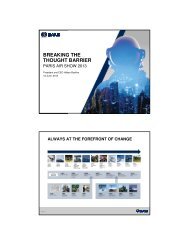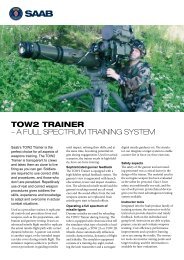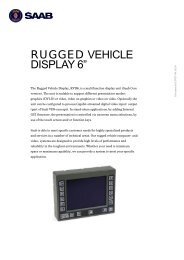SAFE Airport Edition brochure - Saab
SAFE Airport Edition brochure - Saab
SAFE Airport Edition brochure - Saab
You also want an ePaper? Increase the reach of your titles
YUMPU automatically turns print PDFs into web optimized ePapers that Google loves.
safe<br />
airport edition
safe airport edition<br />
addressing<br />
your challenges<br />
<strong>SAFE</strong> is a user-friendly, flexible and cost-efficient system<br />
designed to provide superior situational awareness. It is ideal for<br />
managing people and other resources as well as additional support<br />
systems. The system offers outstanding integration capabilities<br />
and complete configurability, which means increased efficiency,<br />
decreased costs and no development needed for new customer<br />
installations.<br />
<strong>SAFE</strong> provides role-based situation awareness and information<br />
distribution between users which improve customer critical<br />
operational flows. It allows clients to view the exact same situational<br />
picture and also share information about areas, flows, layouts, track<br />
labels and more among themselves. The systems’ easy-to-use interface<br />
is easily adapted when business flows or processes improve<br />
or change.<br />
In the complex environment of, for instance, an airport quick<br />
response to any alarm or disruption is essential when lives or<br />
infrastructure are at risk. By delivering unique real-time business<br />
intelligence and instant information sharing, the <strong>SAFE</strong> system<br />
can shorten response times, optimize operations and improve<br />
business flows.<br />
The <strong>SAFE</strong> system is highly capable and addresses the most<br />
challenging demands of day-to-day operations as well as those in<br />
severe crisis management. It is a great system for operating and<br />
controlling any venture or business, providing unique capabilities<br />
when it comes to enhancing situational awareness, increasing<br />
security, improving business flows and reducing costs.<br />
2
safe airport edition<br />
safE airport edition<br />
main functionalities<br />
today, airports are facing demanding challenges.<br />
The threat situation, the competition, and new regulations – they<br />
all call for solutions with the ability to increase and ensure safety,<br />
security and efficiency alike. <strong>SAFE</strong> covers all the needs of an airport,<br />
making it possible to optimize the flow and safety of people<br />
and goods, without compromising security.<br />
<strong>SAFE</strong> is a modular system offering a variety of configuration<br />
possibilities. It can be fully adapted to suit any operational need<br />
at any given time.<br />
Key characteristics for the <strong>SAFE</strong> system are; a uniform environment,<br />
easy to add functionality and a task-specific user interface.<br />
The system design enables different modules to be deployed simultaneously<br />
and the addition or exclusion of new functionalities by<br />
merely plugging in or removing modules. This ensures cost-efficient<br />
operations scaled to precise customer needs.<br />
Main functionalities included in and necessary for running<br />
the <strong>SAFE</strong> <strong>Airport</strong> <strong>Edition</strong>:<br />
• Information sharing, making communication easier and quicker,<br />
providing users with a common and superior situational picture.<br />
• Decision support, by making action plans for critical situations<br />
available to all authorized users at all times helps and support<br />
decision-making.<br />
• Workflow management that allows a continuous business flow<br />
and improves operational performance and efficiency.<br />
• Logging of events and activities which provides statistics that can<br />
be used for SLA fulfillment and operational improvements.<br />
• Map functionality displaying where different resources and issues<br />
are positioned and what privileges each resource has.<br />
• One common interface, meaning that the information from <strong>SAFE</strong><br />
and the sub systems is uniformly presented to all users.<br />
• Scalability, making it possible for different roles to have<br />
customized layouts and dedicated equipment (PDA, touch screen,<br />
installations with reduced functionality) and the ability to easily<br />
extend the number of clients.<br />
BASE MODULES<br />
OPERATOR<br />
CLIENT<br />
COMMON<br />
OPERATIONAL<br />
PICTURE<br />
WORKFLOW<br />
MANAGEMENT<br />
RULE ENGINE<br />
INTEGRATION<br />
ENGINE<br />
Flexible administration<br />
System status<br />
Issue management<br />
Sensor rules<br />
Adapter interface<br />
Role based layout<br />
Operational overview<br />
Roles and<br />
responsibility areas<br />
Filtering<br />
Alarm handling<br />
Multi monitor support<br />
GIS Integration<br />
Action plans<br />
Sensor commands<br />
Customizable user<br />
interface<br />
OPTIONS<br />
SUPPORT<br />
INTEGRATION<br />
ENGINE<br />
VIDEO<br />
GATEWAYS<br />
SUPPORT<br />
Access Integration<br />
Video management<br />
• Existing Primary<br />
gateway<br />
• Existing Advanced<br />
gateway<br />
<strong>SAFE</strong> Support<br />
and Supply<br />
Elevator management<br />
3
safe airport edition<br />
this is<br />
how it works<br />
is it possible for one single system to<br />
control and handle all security tasks at an<br />
airport? With <strong>SAFE</strong> it is. In fact, by using<br />
<strong>SAFE</strong>, a great part of the daily work can be<br />
administrated and supervised by operators<br />
in a command center.<br />
Every design decision made during the<br />
development of the <strong>SAFE</strong> <strong>Airport</strong> <strong>Edition</strong><br />
is based on <strong>Saab</strong>’s extensive experience and<br />
understanding of the operational needs of<br />
an airport. This expertise, combined with<br />
the ability to put together a complete and<br />
customized technical solution, allows <strong>SAFE</strong><br />
to optimize routines and improve efficiency<br />
while bringing security to a higher level.<br />
4<br />
There are three main reasons that makes<br />
<strong>SAFE</strong> a great choice for operating and<br />
supervising an airport:<br />
Increased security – <strong>Airport</strong>s and<br />
travel centers using <strong>SAFE</strong> can establish and<br />
maintain a higher level of control and efficiency<br />
with fewer people involved, because<br />
many routines and procedures are handled<br />
automatically by the system.<br />
Integration – The GIS (Geographic<br />
Information System) integration with its<br />
advanced map functionality is key for<br />
creating a common operational picture.<br />
The map displays issues and resources and<br />
in case of an alarm it will provide immediate<br />
access to associated cameras. Any user<br />
logged in to <strong>SAFE</strong> can also use the mapdrawing<br />
tool to highlight an area and manually<br />
move and position resources in the map.<br />
Workflow management – <strong>SAFE</strong><br />
offers a common situational picture where<br />
users can receive and share essential information.<br />
Lists showing all resources, current<br />
assignments, issues and alarms combined<br />
with GIS integration and video surveillance<br />
provide the operator with the tools needed<br />
to control any situation.<br />
<strong>SAFE</strong> is the top layer of the security<br />
solution, the one visible to the operator<br />
and from where the operator performs<br />
all actions and tasks. All other security<br />
systems, in current or future use, may be<br />
integrated with <strong>SAFE</strong>. A <strong>SAFE</strong> installation<br />
is easily maintained and scalable. It may<br />
be upgraded and changed – including the<br />
replacement of subsystems – according to<br />
the business’ changing needs.
Business Intelligence<br />
The ability to quickly adjust and change routes and staffing are vital<br />
for operating an airport efficiently. <strong>SAFE</strong> provide several tools for<br />
assessments and staff planning based on previous data and statistics.<br />
Advanced data mining can be done with the QlikView Business<br />
Discovery Platform, which is available through the <strong>SAFE</strong> GUI.<br />
The <strong>SAFE</strong> System also has a built in reporting functionality that<br />
handles both standard and customized reports.<br />
This helps cut time and money spent in, for instance, security checks<br />
as queues can be detected in real time via video, enabling the planning<br />
of staff numbers required at check-in or passport and security control.<br />
Based on historical flows, efforts can be optimized by day and location.<br />
Dispatch<br />
<strong>SAFE</strong> includes integrated communication solutions and functions<br />
for secure and reliable interaction with various types of mobile<br />
clients and portable units, and between all roles and users within<br />
the system.<br />
The ability to constantly track and route plan resources, combined<br />
with integrated and advanced map functions provide the operator<br />
with the tools needed to optimize the resources available.<br />
<strong>Saab</strong> can also provide a solution for vehicle integration that<br />
combines navigation, information, control panel, GPS, etc. in one<br />
single unit that is fully adaptable to the <strong>SAFE</strong> system.<br />
GIS/Map functionality<br />
The map functionality is essential to maintain control over large geographical<br />
areas and people working with different assignments and<br />
responsibilities. In all security operations a key factor is the common<br />
operational picture, and within airport operations, where people<br />
and other resources are spread over large areas, the map provides<br />
an important foundation for instant information sharing and visual<br />
confirmation of incidents.<br />
Integrated video view<br />
With <strong>SAFE</strong>, no external video system is needed as video views are<br />
already integrated in the system. This means that operators spend<br />
less time changing focus accessing different systems, while more<br />
time can be spent on acting on the incidents and tasks at hand.<br />
Monitoring large areas in pre-defined, recurring video rounds<br />
is one of the most common assignments in an airport. In case of<br />
deviations or incidents, an assignment is created by the operator<br />
and sent to a guard. With <strong>SAFE</strong>’s integrated video system, this is<br />
easily managed and performed with maintained visual focus.<br />
By allowing operators to direct and facilitate flows and detect queues<br />
in real time, the system is a vital support for Business Intelligence.
safe airport edition<br />
customer<br />
references<br />
<strong>SAFE</strong> airport edition is one of three pre-configured editions of<br />
the <strong>SAFE</strong> system. The <strong>Airport</strong> <strong>Edition</strong> has been developed by <strong>Saab</strong>’s<br />
security solution specialists in close cooperation with Swedavia –<br />
the state owned company operating several major Swedish airports.<br />
Two of these airports are Arlanda and Bromma, where <strong>SAFE</strong> is<br />
installed as part of the overall security solution.<br />
Together with a number of subsystems <strong>SAFE</strong> creates a modern<br />
and flexible security solution, with focus on improving security<br />
and increasing efficiency. A user friendly and scalable solution that<br />
is easily adapted to changing operational requirements, as well as<br />
future technical needs.<br />
6
safe airport edition<br />
brief technical<br />
specification<br />
General design decisions<br />
Scalability<br />
<strong>SAFE</strong> uses a SOA architecture built on WCF.<br />
This enables the use of standardized server functionality for load<br />
distribution. Persistent storage is handled using Microsoft SQL Server<br />
which enables the use of redundant database servers and storage<br />
area networks.<br />
Availability<br />
The WCF based SOA architecture enables the use of standardized<br />
methods for service redundancy.<br />
Security<br />
A federated security model using Windows Identity Foundation (WIF)<br />
is used, as well as a claims-based authorization model. This provides<br />
fine granularity for the developer and moves the coarse role-based<br />
configuration to a third party token service.<br />
Maintainability<br />
A modular architecture where C# and .net is used, providing a<br />
high level language with a large framework and garbage collection.<br />
Standard components are used extensively. This limits the amount<br />
of code to be maintained.<br />
<strong>SAFE</strong> Deployment guidelines: <strong>Airport</strong> Prison Medium<br />
A: Primary<br />
B: Secondary<br />
Virtual Servers<br />
Core LAN<br />
Active Directory (AD)<br />
A & B<br />
Virtual Host<br />
VDI Cluster<br />
Virtual Host<br />
AD Federation Server<br />
A & B<br />
Cluster<br />
<strong>SAFE</strong> C2 Server<br />
A & B<br />
Cluster<br />
Server LAN<br />
Virtual Host<br />
Server Cluster<br />
Server LAN<br />
Virtual Host<br />
Core LAN<br />
<strong>SAFE</strong> SIP Server<br />
SQL Server<br />
A: SIP 1<br />
B: SIP 2<br />
A & B<br />
Cluster<br />
Server Cluster<br />
Virtual Center<br />
Virtual Host<br />
Virtual Host<br />
Passage Control System<br />
Backup<br />
Management System<br />
Storage LAN<br />
Storage LAN<br />
Clients & Subsystems<br />
SAN<br />
SAN<br />
PDA Video Clients Mobile TeleCom Vehicles<br />
7
www.saabgroup.com<br />
English - November - 2011




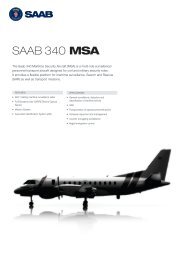
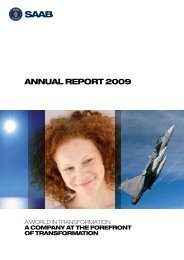
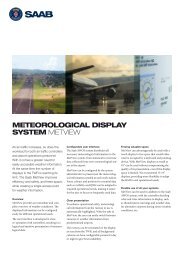
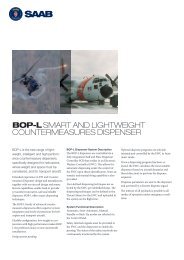

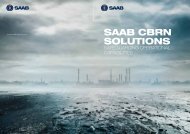
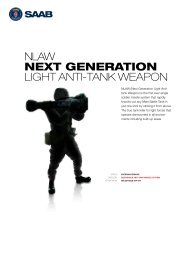
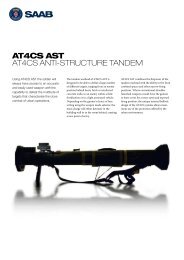

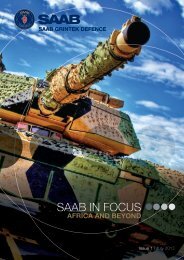
![Proposal long-term incentive programs [pdf] - Saab](https://img.yumpu.com/50411723/1/190x245/proposal-long-term-incentive-programs-pdf-saab.jpg?quality=85)
